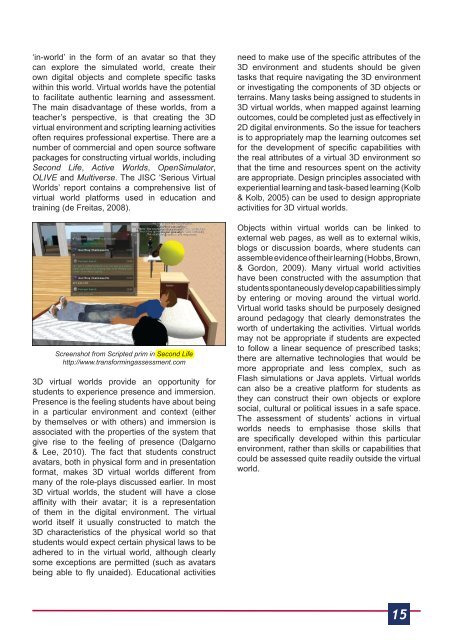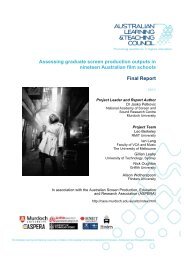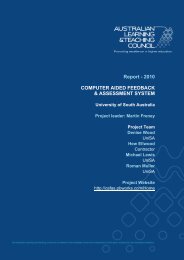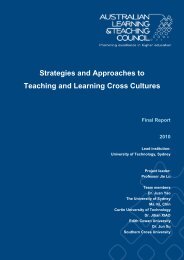Teacher's Handbook on e-Assessment - Office for Learning and ...
Teacher's Handbook on e-Assessment - Office for Learning and ...
Teacher's Handbook on e-Assessment - Office for Learning and ...
Create successful ePaper yourself
Turn your PDF publications into a flip-book with our unique Google optimized e-Paper software.
‘in-world’ in the <strong>for</strong>m of an avatar so that they<br />
can explore the simulated world, create their<br />
own digital objects <strong>and</strong> complete specific tasks<br />
within this world. Virtual worlds have the potential<br />
to facilitate authentic learning <strong>and</strong> assessment.<br />
The main disadvantage of these worlds, from a<br />
teacher’s perspective, is that creating the 3D<br />
virtual envir<strong>on</strong>ment <strong>and</strong> scripting learning activities<br />
often requires professi<strong>on</strong>al expertise. There are a<br />
number of commercial <strong>and</strong> open source software<br />
packages <strong>for</strong> c<strong>on</strong>structing virtual worlds, including<br />
Sec<strong>on</strong>d Life, Active Worlds, OpenSimulator,<br />
OLIVE <strong>and</strong> Multiverse. The JISC ‘Serious Virtual<br />
Worlds’ report c<strong>on</strong>tains a comprehensive list of<br />
virtual world plat<strong>for</strong>ms used in educati<strong>on</strong> <strong>and</strong><br />
training (de Freitas, 2008).<br />
Screenshot from Scripted prim in Sec<strong>on</strong>d Life<br />
http://www.trans<strong>for</strong>mingassessment.com<br />
3D virtual worlds provide an opportunity <strong>for</strong><br />
students to experience presence <strong>and</strong> immersi<strong>on</strong>.<br />
Presence is the feeling students have about being<br />
in a particular envir<strong>on</strong>ment <strong>and</strong> c<strong>on</strong>text (either<br />
by themselves or with others) <strong>and</strong> immersi<strong>on</strong> is<br />
associated with the properties of the system that<br />
give rise to the feeling of presence (Dalgarno<br />
& Lee, 2010). The fact that students c<strong>on</strong>struct<br />
avatars, both in physical <strong>for</strong>m <strong>and</strong> in presentati<strong>on</strong><br />
<strong>for</strong>mat, makes 3D virtual worlds different from<br />
many of the role-plays discussed earlier. In most<br />
3D virtual worlds, the student will have a close<br />
affinity with their avatar; it is a representati<strong>on</strong><br />
of them in the digital envir<strong>on</strong>ment. The virtual<br />
world itself it usually c<strong>on</strong>structed to match the<br />
3D characteristics of the physical world so that<br />
students would expect certain physical laws to be<br />
adhered to in the virtual world, although clearly<br />
some excepti<strong>on</strong>s are permitted (such as avatars<br />
being able to fly unaided). Educati<strong>on</strong>al activities<br />
need to make use of the specific attributes of the<br />
3D envir<strong>on</strong>ment <strong>and</strong> students should be given<br />
tasks that require navigating the 3D envir<strong>on</strong>ment<br />
or investigating the comp<strong>on</strong>ents of 3D objects or<br />
terrains. Many tasks being assigned to students in<br />
3D virtual worlds, when mapped against learning<br />
outcomes, could be completed just as effectively in<br />
2D digital envir<strong>on</strong>ments. So the issue <strong>for</strong> teachers<br />
is to appropriately map the learning outcomes set<br />
<strong>for</strong> the development of specific capabilities with<br />
the real attributes of a virtual 3D envir<strong>on</strong>ment so<br />
that the time <strong>and</strong> resources spent <strong>on</strong> the activity<br />
are appropriate. Design principles associated with<br />
experiential learning <strong>and</strong> task-based learning (Kolb<br />
& Kolb, 2005) can be used to design appropriate<br />
activities <strong>for</strong> 3D virtual worlds.<br />
Objects within virtual worlds can be linked to<br />
external web pages, as well as to external wikis,<br />
blogs or discussi<strong>on</strong> boards, where students can<br />
assemble evidence of their learning (Hobbs, Brown,<br />
& Gord<strong>on</strong>, 2009). Many virtual world activities<br />
have been c<strong>on</strong>structed with the assumpti<strong>on</strong> that<br />
students sp<strong>on</strong>taneously develop capabilities simply<br />
by entering or moving around the virtual world.<br />
Virtual world tasks should be purposely designed<br />
around pedagogy that clearly dem<strong>on</strong>strates the<br />
worth of undertaking the activities. Virtual worlds<br />
may not be appropriate if students are expected<br />
to follow a linear sequence of prescribed tasks;<br />
there are alternative technologies that would be<br />
more appropriate <strong>and</strong> less complex, such as<br />
Flash simulati<strong>on</strong>s or Java applets. Virtual worlds<br />
can also be a creative plat<strong>for</strong>m <strong>for</strong> students as<br />
they can c<strong>on</strong>struct their own objects or explore<br />
social, cultural or political issues in a safe space.<br />
The assessment of students’ acti<strong>on</strong>s in virtual<br />
worlds needs to emphasise those skills that<br />
are specifically developed within this particular<br />
envir<strong>on</strong>ment, rather than skills or capabilities that<br />
could be assessed quite readily outside the virtual<br />
world.<br />
15

















